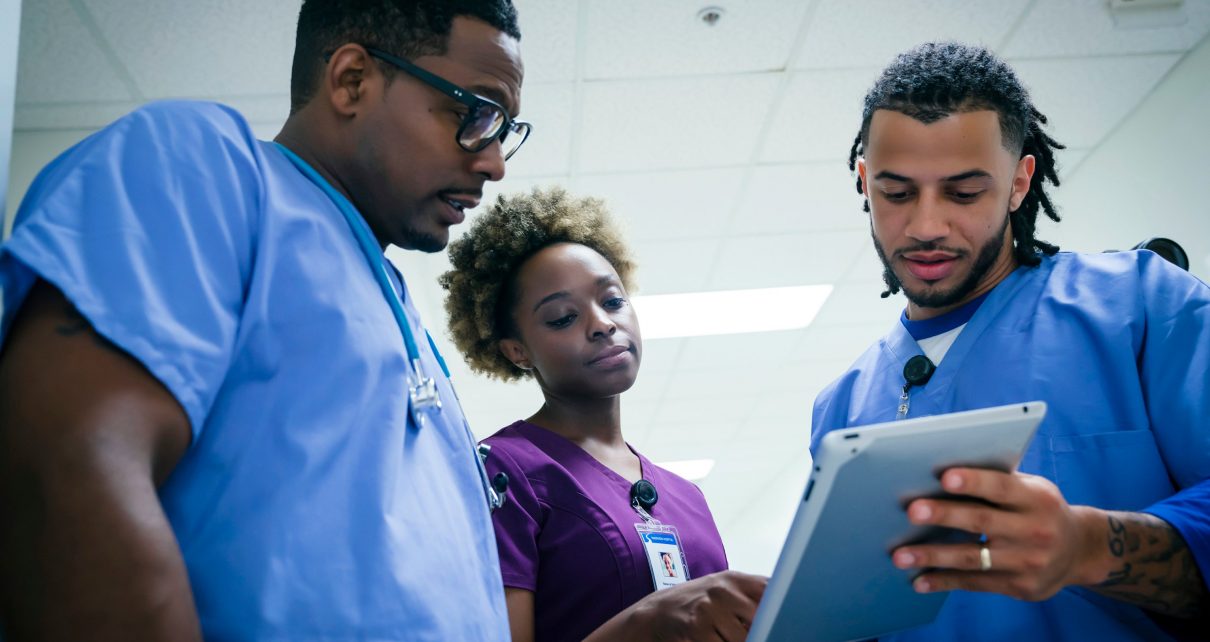The COVID-19 pandemic not only threatens Black communities; it also threatens the Black health care workforce that often serves them. As a physician, I notice workforce discrepancies by race throughout the health professions. In an increasingly diversifying country, we need more Black physicians because they are more likely to work in underserved communities and work on research topics relevant to the health of Black communities, and because Black patients have better outcomes when they see Black physicians. The mortality and morbidity associated with COVID-19 are shrinking the current Black physician workforce, while secondary educational and economic effects are narrow the pipeline from pupil to physician. Without concerted action, existing racial imbalances in the health workforce will grow, potentially exacerbating health disparities in Black communities in the United States.
INTERGENERATIONAL CHALLENGE
The direct effects of COVID-19 on the Black physician workforce starts with current physicians. Data from the CDC find that Black care workers are disproportionately affected by the virus. They account for 21 percent of the COVID-19 infections among all health care workers, while making up only 13 percent of the general population. Extrapolating from the latest CDC’s health care worker death count, this means at least 107 Black health care workers have died, and that is likely an underestimate. Thousands more may be suffering the complications of infection, resulting in time off work to recuperate and to decrease the spread of infection. The small number of Black physicians in the U.S., approximately 45,500 or five percent of U.S. doctors, are not replaceable. Those who have lost their lives or their ability to work because of health complications cannot help the Black communities that now crucially need them.
The loss of Black physicians has secondary consequences on community members themselves. Some Black physicians work at community health centers, which provide primary care for many racial and ethnic minorities. COVID-19 related financial constraints have led to community health center closures, resulting in less access to care for Black patients. At least 18 percent of Black high school sophomores aspire to be physicians. In addition to the loss of important family and community support and encouragement because of COVID-19, these aspiring physicians may lose Black role models, resulting in less guidance, mentorship and opportunities critical to become a physician. Although white physicians can serve as mentors to Black medical aspirants, they are less likely to practice in the communities where Black youth live.
The pandemic added insult to existing structural education and economic barriers for Black students. The wealth of Black and white families remains as disparate as it was in 1968, at $13,024 and $149,703, respectively. Black college students are more likely to have financial pressures that force them to drop out. Across multiple economic measures, Black families have been hit the worst by COVID-19. It makes it difficult to maintain continuity in learning when you have unreliable or no internet service. Although there are many great STEM resources online, rather than acting as equalizers, they may become a platform for those who have the resources to use them. Indeed, because of inequities in remote schooling, Black students from low-income families have delayed progress of 10 months by some estimates. There are concerns that Historically Black Colleges and Universities (HBCUs), which produce a large number of Black physicians, will struggle financially in coming years.
There are additional costs that make the transition from college to medical school to residency challenging for Black students. Fees for exams, the cost of study materials, and traveling for interviews necessary for medical school and residency are expensive. The economic consequences of COVID-19—loss of income and unemployment—may make it more difficult to meet these costs. Students may face a greater need for additional sources of income. Between college and medical school, I worked as a furniture mover, waiter, gallery sitter, lab assistant, research participant, transcriber and election official.
Even today, as a board-certified physician and a fellow in child and adolescent psychiatry, I am working an additional, part-time job to support my elderly parents so they can stay at home rather than risk exposure to COVID-19. While I am fortunate that I am able to do this, I am also cognizant that this is time I could have spent acquiring further skills or professional development that would have furthered my career.
SOLUTIONS NEED TO BE SYSTEMIC
Many people are optimistic that COVID-19 will spur growth of the health care sector. But given the current state of affairs, I am not optimistic that the Black workforce will increase or that Black communities will get the help they need to overcome the structural challenges they face. This is not for lack of effort on the part of Black physicians. Black physicians have done the work, are doing the work and will continue to do the work to support Black communities. The problem is lack of commitment to make systemic change by people in positions of power, who are predominantly white. Therefore, it is incumbent on those in power— accreditation bodies and hospital executives; officials in the departments of Education and Health and Human Services; and private sector executives—to desegregate medicine and participate actively in solutions. Here are some of those possible solutions:
Before medical school
There are several ways to help Black people across the health care pipeline. First, we should eliminate exam and interview fees when possible. The AAMC Fee Assistance Program is a good effort that can be used as model for other stages of training. But it has its limitations such as not covering interview expenses. Colleges and medical schools can contribute to pay fees.
We also need to find ways to increase STEM opportunities for Black students, both through distance learning and conventional means. Finding ways to increase internet access in Black communities is important for engagement in STEM programming. Formal pipeline programs work well. The CARES Act reauthorized the diversity workforce programs including pipeline program funding, and provided some additional funding. This additional funding should prioritize pipeline programs. Given the success of HBCUs in diversifying medicine, funding should be given to HBCUs beyond what is necessary to survive COVID-19 financial difficulties, so they have more investment in health professional programs. Recent philanthropic and private sector donations to HBCUs are also welcomed.
During medical training
The Centers for Medicare & Medicaid Services, which subsidizes residency programs, should provide supplemental funds to residency programs that have more diverse representation. One possibility is a localized population parity, where tiered funds is provided contingent on whether physician diversity aligns with the local community. For example, a residency program serving a population with 40 percent Black population should get more funds if their class is 30–40 percent Black versus 10–20 percent Black.
In addition, medical schools and residency programs should provide mental health support for Black trainees, particularly given disproportionate maltreatment by colleagues and patients. This should be a requirement of workforce diversity grants.
Post-training
Incentivizing mentoring, through tying it to tenure in medicine, would be one way to increase mentorship opportunities. It may be too restrictive to designate mentoring a requirement for tenure, but faculty who mentor, particularly those mentoring diverse physician trainees, deserve credit for this work. Mentoring is a key factor for retention and advancement across the pipeline from pupil to physician to professor for Black trainees. Because of the limited number of Black faculty in academic medicine, they often disproportionately serve as mentors without mentorship for themselves. Including mentorship as part of the tenure process may help expand it and allocate its load more fairly.
We should also remove barriers that hamper funding for Black scientists whose research topics on issues such as health inequities have been considered relatively unimportant, resulting in less success in obtaining research funding. Therefore, NIH study sections, whose role it is to evaluate grant applications, should include more scholars with expertise in these areas. This will necessitate consideration of criteria other than publication records or previous NIH grant funding as there are factors (bias, disparities in mentorship, etc.) that may suppress these numbers for Black physician scientists. Unfortunately, it seems unlikely that Congress will pass the HEROES Act, which would allocate funding for health disparities data collection and research.
To build a workforce to improve the health of Black communities, we cannot continue to do things as usual in the health care profession. COVID-19 has exposed structural issues and ineffectiveness of existing solutions. To build a Black physician pipeline, a more comprehensive and just approach involving health professionals and nonhealth professionals of all races is necessary. Let’s start now.




